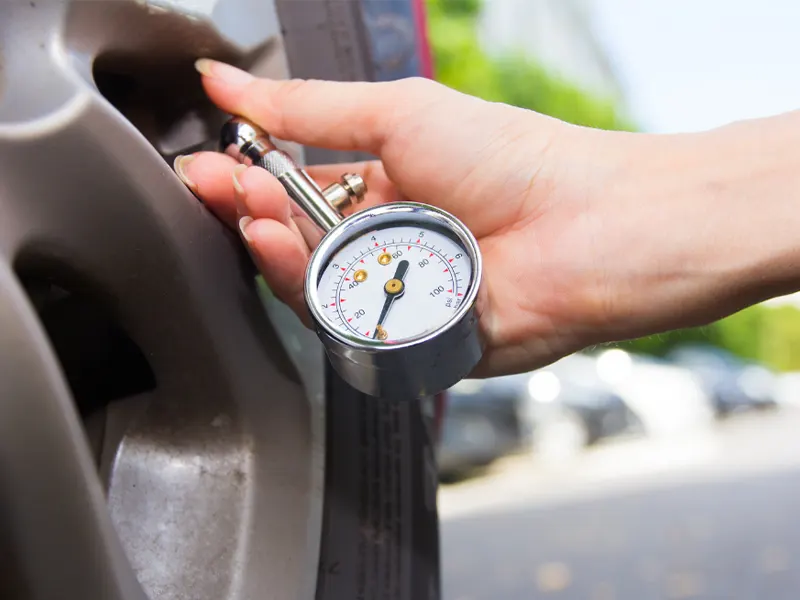Ever hit the road with a nagging suspicion your tires might be a little… deflated? Or maybe you’ve experienced the gut-wrenching jolt of a sudden tire blowout, sending your driving plans and peace of mind screeching to a halt.
Well, say goodbye to those tire terrors and hello to the ultimate safeguard: the Tire Pressure Monitoring System (TPMS).
What is TPMS?
Maintaining proper tire pressure is crucial for vehicle safety and performance. Underinflated tires can increase stopping distances by up to 25%, reduce fuel economy by 3-4%, and are 3 times more likely to experience blowouts. Tire Pressure Monitoring Systems (TPMS) are electronic systems designed to monitor air pressure inside pneumatic tires in real-time.
First introduced in luxury vehicles in the early 2000s, TPMS technology has now become standard in most new cars sold in the US. Modern TPMS can detect underinflation before drivers notice any issues, enhancing road safety.
Types of TPMS
There are two main types of TPMS available:
1. Direct TPMS
Direct TPMS utilizes pressure sensors inside each tire’s valve stem to continuously track real-time air pressure levels and temperature. With individual tire precision down to +/- 1.5 PSI, direct systems provide the highest accuracy and reliability. However, the sensors do require professional installation and periodic battery replacement.
2. Indirect TPMS
Indirect TPMS infers pressure loss by comparing relative rotational speeds of wheels through the Anti-lock Braking System (ABS). Although cheaper and simpler, indirect systems cannot pinpoint individual tire issues, offer slightly delayed pressure loss detection, and overall less precise measurements (+/- 10 PSI).
Components of a TPMS
Direct TPMS configurations contain multiple key components:
- Lithium battery-powered tire pressure sensors screwed into each wheel’s valve stem. These sensors transmit pressure/temp data via radio frequencies.
- A central receiver module mounted inside the vehicle processes signals from tire sensors.
- A dashboard display unit or driver information system provides real-time pressure readouts and warning alerts.
Indirect TPMS relies on existing ABS wheel speed sensors and an electronic control unit (ECU) to process wheel data.
Both systems utilize audible and visual warning systems to indicate problematic pressure loss, malfunctioning sensors, or faults.
Benefits of using TPMS
TPMS delivers numerous safety, performance, and convenience benefits:
- Preventing blowouts and other tire failures reduces accident risk by over 30%. Properly inflated tires also enhance wet braking by up to 20 feet at 50 MPH.
- At just 10 PSI below recommended pressures, rolling resistance increases by 10%, decreasing fuel economy by over 3 MPG. Maintaining inflation maximizes MPG.
- By eliminating gradual underinflation, TPMS can extend tire lifespan by over 30,000 miles – saving over $1000 in lifetime tire costs.
- Automated monitoring eliminates inconvenient manual pressure checks. Early leak detection provides time to address issues.
Installation and Maintenance
Due to sensor synchronization requirements, professional TPMS installation is typically recommended. Sensors must be carefully paired/activated with the vehicle’s receiver through specific procedures.
Direct TPMS sensors contain non serviceable lithium batteries lasting up to 10 years under normal use. Gradual battery depletion can lead to sensor failures, requiring replacement. Software updates may be required as technology evolves.
Future Advancements in TPMS
Integrating tire pressure/temperature monitoring with other systems could enable valuable predictive capabilities. Self-inflating tires paired with TPMS control would eliminate manual filling altogether.
As vehicles become more connected, aggregating anonymized TPMS data from millions of cars could give valuable insights into typical tire performance – transforming predictive analytics and maintenance. Vehicle-to-everything (V2X) communication also offers possibilities for TPMS enhancements.

John Smith, a Los Angeles-based car specialist and automotive writer, boasts over 20 years in the industry. With a background as a master technician and a decade-long writing stint at notable automotive publications, John now shares his expansive knowledge on CarFinite, simplifying car maintenance for readers.

